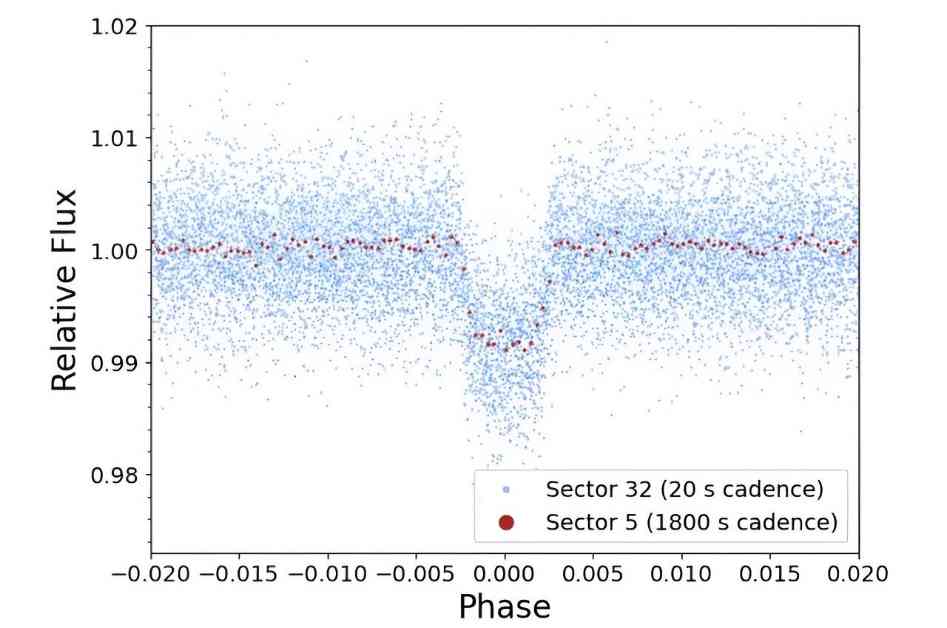Astronomers have recently made an exciting discovery in space – the identification of a massive brown dwarf known as TOI-2490 b. This newfound object, which is approximately 74 times more massive than Jupiter, orbits a sun-like star in a highly eccentric orbit. The discovery was detailed in a paper published on August 8 on the pre-print server arXiv.
Brown dwarfs are intriguing celestial objects that fall between planets and stars in terms of mass. They typically range in mass from 13 to 80 times that of Jupiter. While many brown dwarfs have been identified in the past, those orbiting other stars are considered rare finds.
An international team of astronomers, led by Beth A. Henderson from the University of Leicester in the UK, discovered the transiting brown dwarf TOI-2490 b. Using the Transiting Exoplanet Survey Satellite (TESS), researchers were able to detect a transit signal in the light curve of TOI-2490, a G-type main sequence star located approximately 872.5 light years away. Follow-up observations, including photometric and radial velocity measurements, confirmed the brown dwarf nature of the signal.
TOI-2490 b is roughly the size of Jupiter but significantly more massive, weighing in at about 73.6 Jupiter masses. This gives the brown dwarf a density of 91.6 g/cm3. The object orbits its host star every 60.33 days at a distance of approximately 0.31 astronomical units (AU). The equilibrium temperature of TOI-2490 b is estimated to be 464.2 Kelvin.
One of the most remarkable findings about TOI-2490 b is its high orbital eccentricity, estimated at around 0.78. This characteristic makes it the most eccentric brown dwarf known to orbit within the so-called brown dwarf desert, an area lacking brown dwarfs around main sequence stars within about 3 AU from the host.
Analysis of the collected data led the researchers to conclude that TOI-2490 b likely formed with its high level of eccentricity. They suggest that the brown dwarf may have formed through stellar formation mechanisms and share a similar metallicity and age with its parent star.
The study also revealed that the irradiation temperature of TOI-2490 b fluctuates by approximately 1,000 Kelvin as it moves along its orbit. However, further observations are needed to fully understand this extreme temperature change.
In terms of the host star, TOI-2490, it is comparable in mass to the sun and has a radius of about 1.1 solar radii. The star is estimated to be 7.9 billion years old, with a metallicity of 0.32 dex and an effective temperature of 5,558 Kelvin.
The discovery of TOI-2490 b opens up new avenues for studying the formation and evolution of brown dwarfs in eccentric orbits. The findings from this research provide valuable insights into the properties and behavior of these intriguing celestial objects.
Implications of the Discovery
The identification of TOI-2490 b as a massive brown dwarf in a highly eccentric orbit raises interesting questions about the formation and evolution of such objects. The high eccentricity of TOI-2490 b challenges existing models of brown dwarf formation and highlights the need for further research to understand the processes that lead to the creation of these celestial bodies.
Future Observations and Research
Future observations of TOI-2490 b and its host star, TOI-2490, will provide valuable data for astronomers studying brown dwarfs and their interactions with parent stars. By monitoring the brown dwarf’s temperature fluctuations and orbital behavior, researchers can gain a deeper understanding of the physical properties and dynamics of these enigmatic objects.
Conclusion
The discovery of TOI-2490 b represents a significant advancement in our understanding of brown dwarfs and their characteristics. This newfound object, with its massive size and eccentric orbit, offers a unique opportunity for astronomers to study the formation and evolution of brown dwarfs in unprecedented detail. As researchers continue to investigate TOI-2490 b and its host star, TOI-2490, new insights into the nature of these fascinating celestial bodies are sure to emerge.













